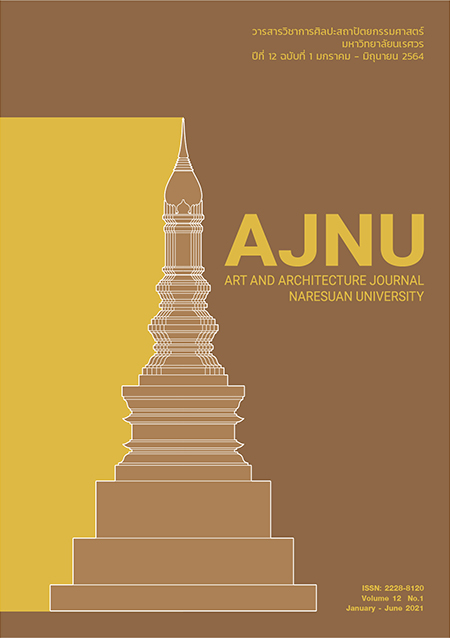Critical Regionalism Theory: An Analysis of Architecture in Rattanakosin Island
Main Article Content
Abstract
This paper analyzes eight cases of architecture in Rattanakosin Island on the theory of Critical Regionalism, posited by Kenneth Frampton. It analyzed forms, elements, materials while also examining their contextual relevance, which aimed at a new interpretation of Rattanakosin Island’s architecture in the theoretical viewpoint of Critical Regionalism. The finding reveals that all of them imbue the grammars of Critical Regionalism architecture. According to the analysis, the attribute of Critical Regionalism as the identity of these buildings are characterized by 1) For institutional building type, they are likely shaped by a peculiar grammar which intertwines fragmented planning schemes with details of mass and volume, for instance, the use of sun breakers, and even abstraction of forms; 2) The cases embodied meticulous-detail decoration, including colors and textures of materials and skin adornments for commercial buildings. Pastiche, however, was also found in some buildings decorated in flashy colors and tones. The commercial type focuses more on tactile sensibility since they pursue an intimate interaction of the users; these tactics, thus, heightened the experience for the users. The cases demonstrated various approaches relevant to Frampton’s theory; however, transcending the listed techniques of Frampton, some cases furthered employ discourses on memory and marketing themes and, for the cases of renovation, it revealed a technique of deepening the building skins in order to display the old memory that used to be concealed.
Article Details
References
คณะสถาปัตยกรรมศาสตร์ สถาบันเทคโนโลยีพระจอมเกล้าเจ้าคุณทหารลาดกระบัง. (2547). มรดกความงามของสภาพแวดล้อมท้องถิ่นไทย. กรุงเทพฯ: คณะสถาปัตยกรรมศาสตร์ สถาบันเทคโนโลยีพระจอมเกล้าเจ้าคุณทหารลาดกระบัง.
คมสัน ธีรภาพวงศ์. (2548). การกลายความคุ้นเคยในสถาปัตยกรรมร่วมสมัย ที่มีผลต่ออัตลักษณ์พื้นถิ่นใหม่: กรณีศึกษาภูมิภาคเอเชียอาคเนย์” วารสารวิจิตรศิลป์ มหาวิทยาลัยเชียงใหม่ 1(1): 158-173.
ชาตรี ประกิตนนทการ. (2552). ศิลปะ สถาปัตยกรรมคณะราษฎร สัญลักษณ์ทางการเมืองในเชิงอุดมการณ์. กรุงเทพฯ: ศิลปวัฒนธรรม.
ชาตรี ลดาลลิตสกุล. (2538). สถาปัตยกรรม จิตตะวันออกในร่างสากล. วารสารสมาคมสถาปนิกสยามในพระบรมราชูปถัมภ์ 12(45), 58-60.
พัฒนา กิติอาษา. (2546). ท้องถิ่นนิยม: Localism. (พิมพ์ครั้งที่ 2). กรุงเทพมหานคร: กองทุนอินทร์-สมเพื่อการวิจัยทางมานุษยวิทยา.
นวนัฐ โอศิริ. (2548). "ภูมิภาคนิยมเชิงวิพากษ์: ในงานภูมิทัศน์เมืองเขตร้อนชื้น" วารสารวิชาการคณะสถาปัตยกรรมศาสตร์ ฉบับงานบริการวิชาการสู่สังคม ภาควิชาภูมิสถาปัตยกรรม. 1(2548): 51.
วิมลสิทธิ์ หรยางกูร (บรรณาธิการ). (2560). เปิดมิติเอกลักษณ์สถาปัตยกรรมไทยสมัยใหม่. กรุงเทพฯ: สำนักพิมพ์มหาวิทยาลัยธรรมศาสตร์
วิมลสิทธิ์ หรยางกูร และคนอื่น ๆ. (2536). พัฒนาการความคิดและรูปแบบของงานสถาปัตยกรรม อดีต ปัจจุบัน และอนาคต. กรุงเทพมหานคร: สมาคมสถาปนิกสยาม.
วิมลสิทธิ์ หรยางกูร. (2529). ปัญหาเอกลักษณ์สถาปัตยกรรม. วารสารสมาคมสถาปนิกสยามในพระบรมราชูปถัมภ์ 12(1), 74-79.
วิวัฒน์ เตมียพันธ์. (2524). รายงานการวิจัยปีการศึกษา เรือนเครื่องผูกชาวนา (โรงนา) ที่หมู่ 1 ตำบลคอกกระบืออำเภอเมืองสมุทรสาคร จังหวัดสมุทรสาคร. กรุงเทพมหานคร: ทริปเพิ้ล กรุ๊ป.
วิวัฒน์ เตมียพันธ์. (2525). ความสำคัญของสถาปัตยกรรมท้องถิ่น. เอกสารอัดสำเนา.
วีระ อินพันทัง. (2545). รายงานการวิจัย เหย้าเรือนพื้นบ้านย่านตะวันตก. เอกสารอัดสำเนา.
ศรีศักดิ์ พัฒนวศิน. (2545). ทัศนคติต่อที่ว่าง อัตลักษณ์ที่ซ้อนเร้นในสถาปัตยกรรมพื้นถิ่นเอเชียร่วมสมัย. วารสารวิจัยและสาระสถาปัตยกรรม คณะสถาปัตยกรรมศาสตร์ มหาวิทยาลัยธรรมศาสตร์. 1, 129-153.
อรศิริ ปาณินท์ และคนอื่น ๆ. (2527). รายงานวิจัยลักษณะอาคารพักอาศัยย่านคลองบางกอกน้อย. กรุงเทพฯ: คณะนิเทศศาสตร์ จุฬาลงกรณ์มหาวิทยาลัย.
เอกรินทร์ พึ่งประชา. (2545). สถาปัตย์อุจาดสะท้อน ‘ความเป็นไทย’ อย่างศรีธนญชัย’ ทัศนวิพากษ์ของ ดร. สุเมธ ชุมสาย ณ อยุธยา. ศิลปวัฒนธรรม. 23(11), 33.
Eggener, K. (2002). Placing resistance: A critique of critical regionalism. Journal of Architectural Education. 55(4), 228-237.
Fathy, H. (1973). Architecture for the poor: An experiment in rural Egypt. Chicago and London: University of Chicago Press.
Frampton, K. (1992). Modern architecture: A critical history. London: Thames and Hudson Ltd.
King, R. (2006). Nation, anti-Nation, and the hazards of heritage. เอกสารประกอบการประชุมวิชาการนานาชาติ สถาปัตยปาฐะ สถาปัตยกรรมในดินแดนสุวรรณภูมิ. กรุงเทพฯ: คณะสถาปัตยกรรมศาสตร์มหาวิทยาลัยศิลปากร.
Noobanjong, K. (2003). Power, identity, and the rise of modern architecture: From Siam to Thailand PhD., University of Colorado at Denver, Denver, USA.
Rudofsky, B. (1964). Architecture without architects: A short introduction to non-pedigreed architecture. New York: Doubleday & Company.
Thaveeprungsriporn, P. (2546). Ruan Thai: An Aesthetic of Feminity?. ในเทิดศักดิ์ เตชะกิจขจร (บรรณาธิการ). ภูมิปัญญาสถาปัตยกรรม. (หน้า 67-96). กรุงเทพฯ: ศูนย์ตำราและเอกสารวิชาการ คณะสถาปัตยกรรมศาสตร์ จุฬาลงกรณ์-มหาวิทยาลัย.


